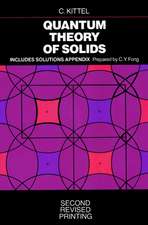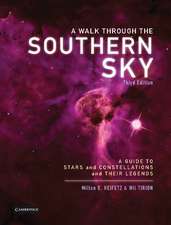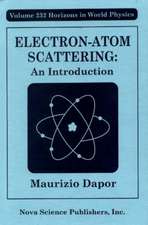Progress in Atomic Spectroscopy: Part D: Physics of Atoms and Molecules
Editat de H.J. Beyer, Hans Kleinpoppenen Limba Engleză Paperback – 17 oct 2011
Din seria Physics of Atoms and Molecules
-
 Preț: 399.88 lei
Preț: 399.88 lei - 18%
 Preț: 1226.73 lei
Preț: 1226.73 lei - 18%
 Preț: 1268.07 lei
Preț: 1268.07 lei -
 Preț: 386.99 lei
Preț: 386.99 lei - 18%
 Preț: 959.98 lei
Preț: 959.98 lei - 15%
 Preț: 650.55 lei
Preț: 650.55 lei - 18%
 Preț: 948.47 lei
Preț: 948.47 lei -
 Preț: 404.29 lei
Preț: 404.29 lei - 18%
 Preț: 954.77 lei
Preț: 954.77 lei - 15%
 Preț: 685.20 lei
Preț: 685.20 lei - 18%
 Preț: 1260.34 lei
Preț: 1260.34 lei - 5%
 Preț: 658.82 lei
Preț: 658.82 lei - 15%
 Preț: 661.14 lei
Preț: 661.14 lei - 18%
 Preț: 953.35 lei
Preț: 953.35 lei -
 Preț: 402.17 lei
Preț: 402.17 lei - 15%
 Preț: 645.47 lei
Preț: 645.47 lei - 18%
 Preț: 1222.49 lei
Preț: 1222.49 lei - 18%
 Preț: 959.67 lei
Preț: 959.67 lei - 18%
 Preț: 952.72 lei
Preț: 952.72 lei - 15%
 Preț: 664.43 lei
Preț: 664.43 lei - 18%
 Preț: 952.89 lei
Preț: 952.89 lei - 15%
 Preț: 662.16 lei
Preț: 662.16 lei -
 Preț: 392.75 lei
Preț: 392.75 lei - 20%
 Preț: 555.28 lei
Preț: 555.28 lei - 15%
 Preț: 638.57 lei
Preț: 638.57 lei - 15%
 Preț: 648.24 lei
Preț: 648.24 lei - 18%
 Preț: 1233.06 lei
Preț: 1233.06 lei - 18%
 Preț: 1233.83 lei
Preț: 1233.83 lei -
 Preț: 390.08 lei
Preț: 390.08 lei - 18%
 Preț: 957.44 lei
Preț: 957.44 lei -
 Preț: 389.49 lei
Preț: 389.49 lei - 18%
 Preț: 950.66 lei
Preț: 950.66 lei - 15%
 Preț: 603.70 lei
Preț: 603.70 lei - 15%
 Preț: 587.85 lei
Preț: 587.85 lei - 15%
 Preț: 643.65 lei
Preț: 643.65 lei - 18%
 Preț: 1230.84 lei
Preț: 1230.84 lei
Preț: 651.02 lei
Preț vechi: 765.90 lei
-15% Nou
Puncte Express: 977
Preț estimativ în valută:
124.57€ • 129.81$ • 103.15£
124.57€ • 129.81$ • 103.15£
Carte tipărită la comandă
Livrare economică 03-17 aprilie
Preluare comenzi: 021 569.72.76
Specificații
ISBN-13: 9781461290360
ISBN-10: 1461290368
Pagini: 540
Ilustrații: XXIII, 514 p.
Dimensiuni: 152 x 229 x 28 mm
Greutate: 0.71 kg
Ediția:Softcover reprint of the original 1st ed. 1987
Editura: Springer Us
Colecția Springer
Seria Physics of Atoms and Molecules
Locul publicării:New York, NY, United States
ISBN-10: 1461290368
Pagini: 540
Ilustrații: XXIII, 514 p.
Dimensiuni: 152 x 229 x 28 mm
Greutate: 0.71 kg
Ediția:Softcover reprint of the original 1st ed. 1987
Editura: Springer Us
Colecția Springer
Seria Physics of Atoms and Molecules
Locul publicării:New York, NY, United States
Public țintă
ResearchCuprins
of Part D.- 1 Laser-Microwave Spectroscopy.- 1. Introduction.- 2. Classification of Laser-Microwave Spectroscopy.- 3. Measurements Based on Optical Pumping.- 4. Measurements Based on Double Resonance.- 5. Measurements Based on Nonlinear Phenomena.- 6. Other Schemes.- 7. Laser-Microwave Heterodyne Techniques for Spectroscopic Purposes.- 8. Concluding Remarks.- References.- 2 Collinear Fast-Beam Laser Spectroscopy.- 1. Introduction.- 2. Basic Concept and Experimental Realization.- 3. Experiments Based on the Doppler Effect.- 4. Spectroscopic Studies.- 5. Spectroscopy on Unstable Isotopes.- 6. Conclusion.- References.- 3 Radiofrequency Spectroscopy of Rydberg Atoms.- 1. Introduction.- 2. Rydberg Atoms.- 3. Core Polarization and Penetration.- 4. Experimental Techniques.- 5. Overview of the Results Obtained.- References.- 4 Rydberg Series of Two-Electron Systems Studied by Hyperfine Interactions.- 1. Introduction.- 2. Experimental Techniques.- 3. Even-Parity Rydberg Series of Alkaline-Earth Elements.- 4. Odd-Parity Rydberg Series of Alkaline-Earth Elements.- 5. Hyperfine Structure and Isotope Shifts of Rydberg States of Other Two-Electron Systems.- 6. Conclusion.- References.- 5 Parity Nonconservation in Atoms.- 1. Introduction.- 2. Theory.- 3. Circular Dichroism and Optical Rotation—Rigorous Discussion.- 4. Optical Rotation Experiments.- 5. Stark-PNC Experiments; Cesium and Thallium.- 6. Discussion of Results; Conclusions.- References.- 6 Energy Structure of Highly Ionized Atoms.- 1. Introduction.- 2. General Energy Relations in Isoelectronic Ions.- 3. Survey of the Low Configurations in Isoelectronic Sequences.- 4. The n = 2 Configurations.- 5. The Neon Sequence (N = 10).- 6. Ions with Ground Configurations of 3s and 3p Electrons.- 7. The Configurations 3dk.- 8. TheCopper Sequence (N = 29).- 9. The Silver Sequence (N = 47).- References.- 7 Inner-Shell Spectroscopy with Hard Synchrotron Radiation.- 1. Introduction.- 2. Instrumental Details.- 3. X-Ray Absorption by Free Atoms.- 4. X-Ray Absorption by Bound Atoms.- 5. Induced X-Ray Fluorescence and Auger-Electron Emission.- 6. Scattering of X-Rays.- References.- 8 Analysis and Spectroscopy of Collisionally Induced Autoionization Processes.- 1. Introduction.- 2. Description of Autoionizing States.- 3. Experimental Methods.- 4. Line Shapes and Interference Effects in Autoionization Spectroscopy.- 5. Spectroscopic Data for Various Atoms.- 6. Correlated and Uncorrelated Angular Distributions of Autoionization Electrons.- 7. Electron Emission from Quasimolecules.- References.- 9 Near Resonant Vacancy Exchange between Inner Shells of Colliding Heavy Particles.- 1. Introduction.- 2. Theoretical Methods.- 3. Two-State Systems.- 4. Multistate Systems.- 5. Conclusions.- References.- 10 Polarization Correlation in the Two-Photon Decay of Atoms.- 1. Introduction.- 2. Theoretical Considerations.- 3. Experimental Work.- 4. Discussion.- References.















